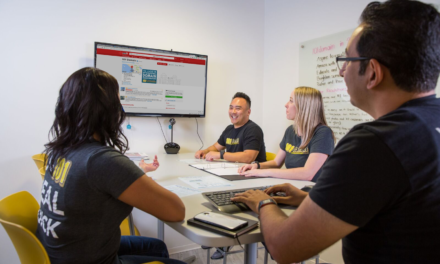Last week Hannah and I headed to San Francisco for Brightedge’s Share 2016.
This was our first marketing conference and we were really excited to soak up as much knowledge as we could during the 3-day event. We delved into the Brightedge platform, geeked out over the new features being released and brainstormed ways to turn our marketing department into a revenue center.

Here are some of our greatest takeaways:
- Customer touchpoints have reached a new level. BrightEdge Founders, Jim Yu and Lemuel Park, kicked off the conference with their keynote/club appearance (jokes). Digital has disrupted everything we as marketers thought we knew and the momentum isn’t stopping. The customer journey consists of “micro touchpoints” which include reviews, real-time content, shared experiences, and online guidance.
- Optimize your content. In both Yu’s and Park’s speeches, we were given a look into new products they are unveiling – one being Intelligent Experience. This feature helps marketers create the right content faster. It gives marketers accurate and actionable insights, which will hopefully drive successful content related strategies. We look forward to trying this one out.
- On the topic of content, we were also urged to begin paid ad campaigns for content, not just for products/services you want to be purchased. This not only will inform your consumers but you will come off less pushy and more interested in their well-being as opposed to a potential purchase you may get.
- Three words: above-the-fold. Instead of only trying to rank for the number one spot organically, focus on ranking for Google Answer boxes which satisfy who, what, where and how questions. If you can rank organically, optimize your content with results for Google Answer boxes, and fill a paid advertising spot at the top, your brand is going to occupy most of the real estate above the fold and customers will be more likely to click on your website.

- Determine a customer’s dormant needs versus their active needs, and focus your content on these pain points. You don’t want to be chasing after a need that may not exist tomorrow.
- Build for website for mobile first. Think about anything that can make the mobile experience better. Filling out forms on mobile takes way more time than on a desktop, which can lead to abandonment. Start to understand these pain points because Google will be moving to mobile. Get your AMP pages in check (this is a note to self, as well).
- Search and social are the front line to the customer so treat them nicely and be available.
- Long tail keywords on your blog are your low hanging fruit. Focus on targeting these first. We’ve all heard this one before but repeat it enough, and hopefully it’ll stick.
- Focus on three keywords in every piece of content. Keywords one and two should be in the Title, H1, and meta description and keyword three in the body text. Opt for different versions of the keywords throughout.

- Page speed is important. If your page takes longer than three seconds to load, consider that a pain point as well as a lost customer. We live in an age of instantaneity – there are too many products and services out there to make your customer wait.
- If you notice customers aren’t interacting with a certain campaign, funnel them back through a general campaign. You may be offering something too specific and doesn’t fit their individual needs, when the consumer is looking for a more general product/feature.
- You should be reusing, recycling and repurposing content. Don’t reshare your content word for word but there’s no shame in revisiting and improving content. Try to reuse under 200 words.
- Build PR relationships for backlinks. Don’t be thirsty and pay for backlinks – you’re better than that! Just make really awesome content people can’t help but to share (sounds easy right?). @Chris Attewell, SVP Americas, Search Laboratory.
- Artificial Intelligence is the future of marketing. For now, A.I. isn’t replacing us like many skeptics may fear because we create the content, the strategy, and most importantly – the creativity. However, we are all already using A.I. in our daily activities (even if we don’t realize), and soon it will become a trusted part of marketing outreach. @Allen Nance, CMO Emarsys.
- And finally, we learned that every marketer loves the word “robust.”
Now back in San Diego, we’re excited to start implementing these “robust” ideas into our marketing practices at 101domain. We already miss the city and are hoping to visit again soon, until then we’ll be looking out for our invite to Share 2017!





